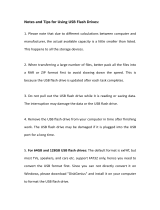
Preventing Electrostatic Damage to Equipment ................................................................ 20
Personal Grounding Methods and Equipment ................................................................... 21
Grounding the Work Area .................................................................................................. 21
Recommended Materials and Equipment .......................................................................... 21
Operating Guidelines .......................................................................................................................... 22
Routine Care ...................................................................................................................................... 23
General Cleaning Safety Precautions ................................................................................ 23
Cleaning the Computer Case ............................................................................................ 23
Cleaning the Keyboard ...................................................................................................... 23
Cleaning the Monitor .......................................................................................................... 24
Cleaning the Mouse ........................................................................................................... 24
Service Considerations ...................................................................................................................... 24
Tools and Software Requirements .................................................................................... 24
Screws ............................................................................................................................... 24
Cables and Connectors ..................................................................................................... 25
Hard Drives ........................................................................................................................ 25
Lithium Coin Cell Battery ................................................................................................... 25
6 Illustrated parts catalog ............................................................................................................................... 26
Computer major components ............................................................................................................. 26
Boards, memory, processors ............................................................................................................. 27
Mass storage devices (not illustrated) ................................................................................................ 28
Cables ................................................................................................................................................ 29
Misc parts ........................................................................................................................................... 30
Sequential part number listing ............................................................................................................ 31
7 Removal and Replacement Procedures All-in One (AIO) Chassis ........................................................... 33
Preparing to Disassemble the Computer ........................................................................................... 33
Rear Cover ......................................................................................................................................... 34
Stand .................................................................................................................................................. 36
Webcam Module ................................................................................................................................ 37
Converter Board ................................................................................................................................. 40
Optical Drive ....................................................................................................................................... 44
Hard Drive .......................................................................................................................................... 47
System Board Cover .......................................................................................................................... 49
Memory .............................................................................................................................................. 51
WLAN Module .................................................................................................................................... 53
Fan ..................................................................................................................................................... 56
Heat Sink (Thermal Module) .............................................................................................................. 58
Processor ........................................................................................................................................... 60
Optical Drive Cables and Connector .................................................................................................. 62
vi




















